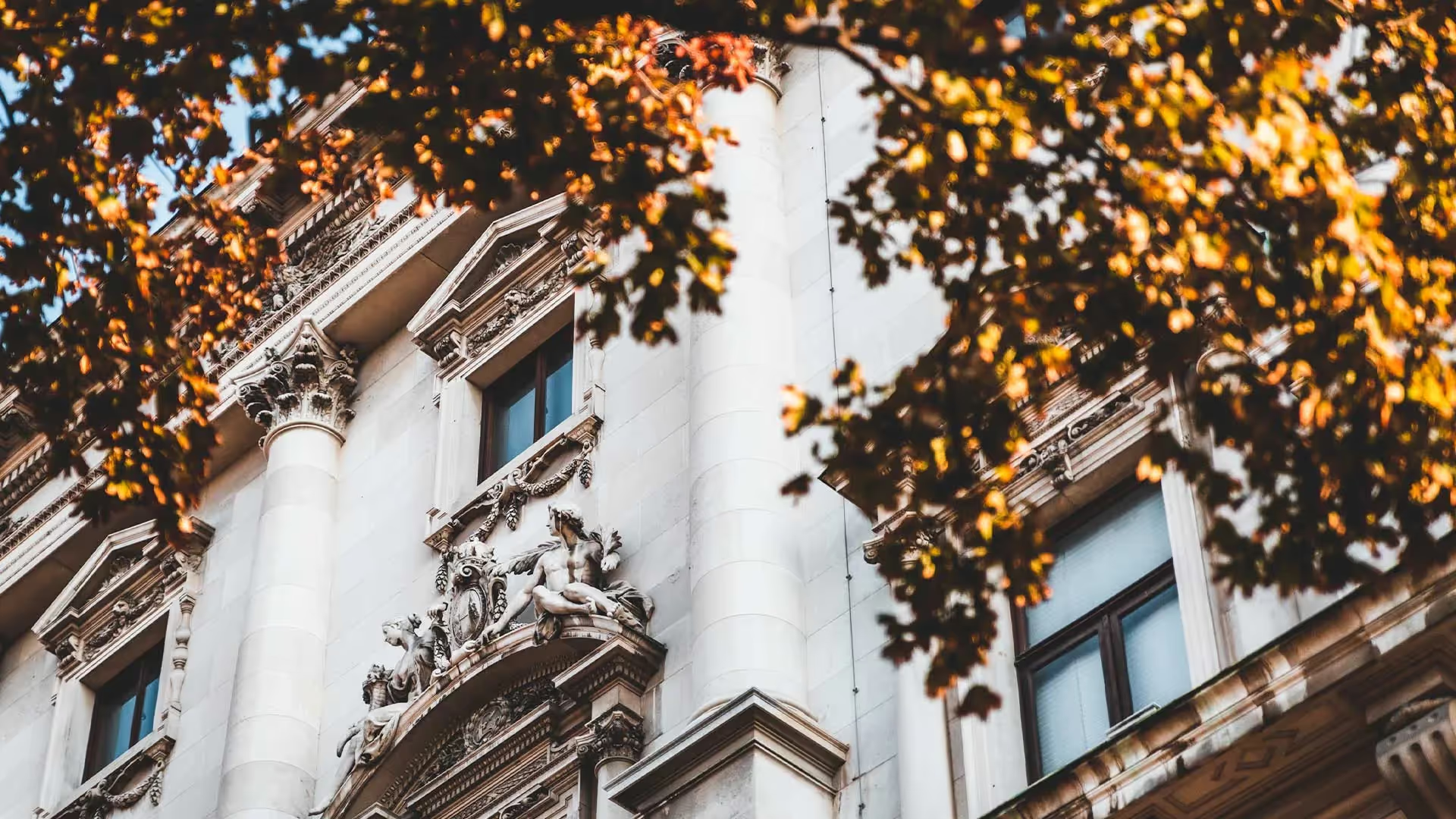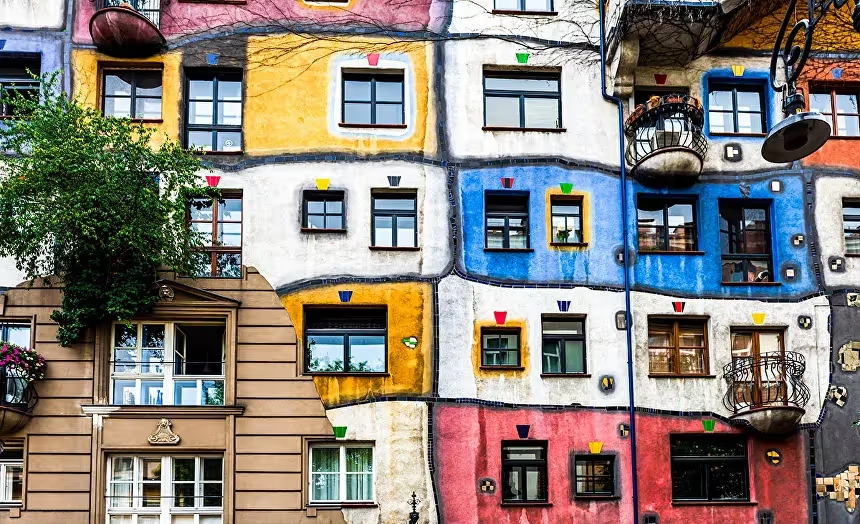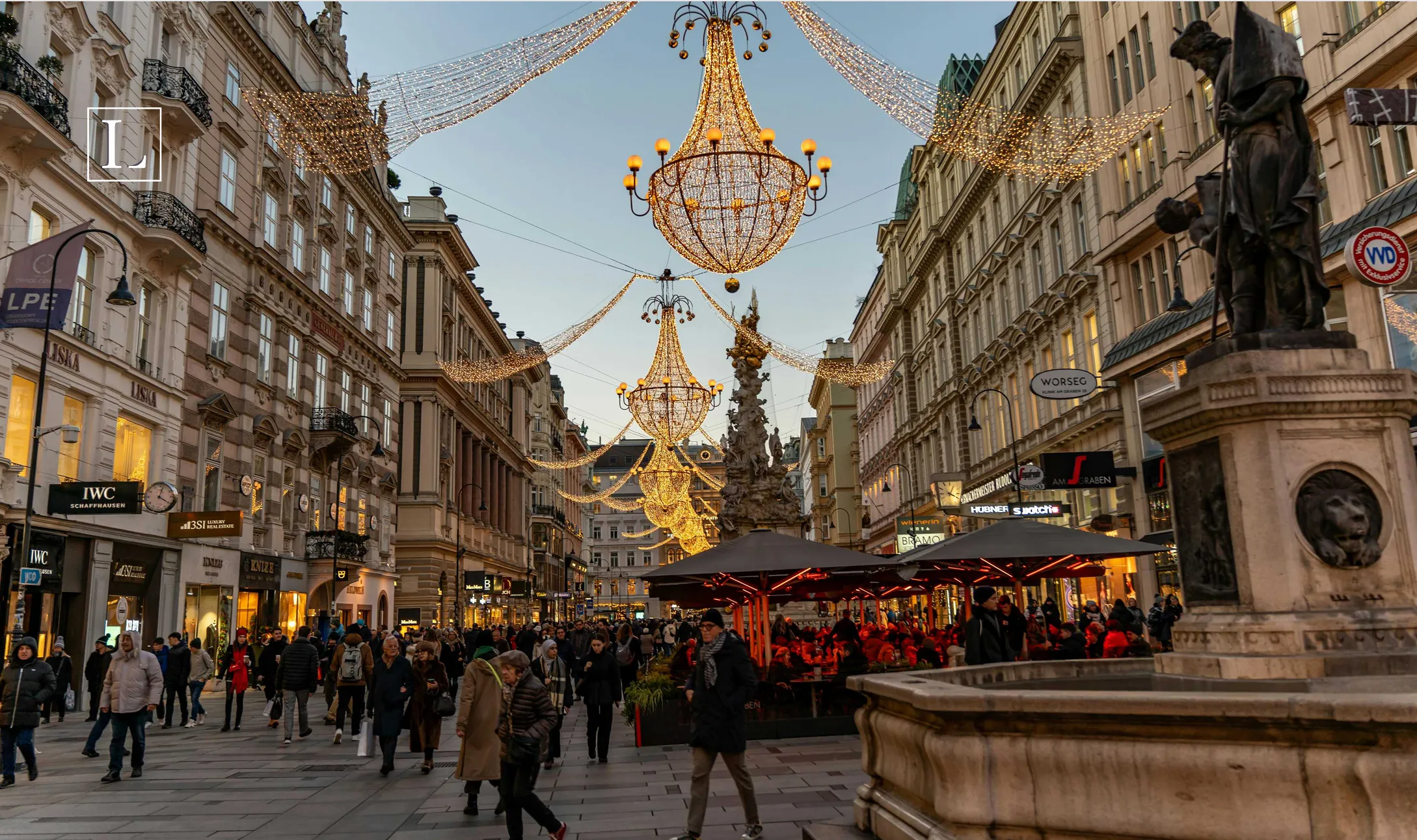Top 10 Most Interesting and Strange Buildings in Vienna
Interesting architectural buildings in Vienna - Top 10 of the strangest historical and modern buildings. Their features, where they are located.

When you think about Vienna architecture, you imagine palaces, baroque cathedrals, and the narrow streets of old towns. However, the city's streets hide rather strange buildings that someone can find ridiculous, even ugly. But some may find them a creation of modern art. You may decide for yourself by reviewing this article on the top-10 of the strangest buildings in Vienna.
1. The Hundertwasserhaus
Hundertwasser House (German: Hundertwasserhaus) is a residential building in Vienna, Austria. Address: Kegelgasse 36-38, A-1030 Wien, a corner from Löwengasse 41-43. The house has fifty-two apartments, аll with a different facade color, four offices, sixteen private and three communal terraces.
Most likely, most people have never heard Friedensreich Hundertwasser's name, although he is highly respected in Austria. Hundertwasser designed all his houses for free. However, he made a deal with the city, that nothing "hideous" by his opinion would be built on his project's places. He hated straight lines and angles and designed his projects as a unique combination of architecture and nature. There are 19 gardens with 250 trees on the roof. The whole house looks like it was invaded by nature. Bushes, grass, and trees can be found not only on the roof but on balconies, terraces, and facades.

Hundertwasser House is composed of random elements of architecture. Bright, patchwork-like walls and undulating floors look like an utterly illogical solution, but thanks to them, the house enjoys immense popularity in Europe. However, many people find it kitschy and ugly.
Building structure and multicolored painted facade earned it the name of the most eccentric municipal building in Vienna.
At some point, the residents got tired of the numerous tourists, and the house was closed to the public. After 1990 the city council demolished the car parking next to it and built the Hundertwasser Village. It's built in the same style that Hundertwasser House and has no entrance fee. Everything inside is a creation of art, even a toilet with a fountain at the entrance, located in the basement.
You can get there by U-Bahn using U3 (Landstraße, Rochusgasse) or U4 (Landstraße). You will need to walk from the metro station an additional 700 m, which should take you no more than 10 minutes. If you choose to take the tram, the nearest stops would be Radetzkyplatz Platz for 0 and Hetzgasse for 1.
2. The KunstHausWien
Variegated surfaces, irregular shapes, an abundance of greenery. No, it is not Hundertwasserhaus again. It's it more conservative version created by the same architect. He built his project as an exhibition center, where you can find both the works of Hundertwasser himself and the most exciting exhibitions of contemporary art.
The architect Hundertwasser completely rebuilt the building of the former furniture factory Thonet in his signature style. The unevenly arranged multicolored glass, metal, tiles, wood, and ceramic elements have a unique look to the previously gray structure. A permanent exhibition of Hundertwasser works occupies two floors. The other two are given over to temporary exhibits. Downstairs there is a cafe, restaurant, and shopping area.
.avif)
The ground floor also houses the Garage, where artists and other creative personalities ardently discuss Hundertwasser's theses on sustainability, climate change, resource recycling, and urbanization. And on the ground floor is the so-called "Gallery," which showcases contemporary photographers' work. The entrance to the KunstHausWien Museum Hundertwasser is € 11 for adults and € 5 for children.
If you want to get there by metro, you should use U3 or U4 and get off at the Landstraße stop. After that, you will walk for about 12 minutes on foot. If you are using the tram, take numbers "0" or "1" and get off Radetzky Platz stop. From there, you need to walk about 350 m.
3. The Spittelau
The most unexpected building on this list. As it is the waste incineration plant. However, it has been designed by the same person - Friedensreich Hundertwasser. The building has unusually straight walls for his style but nevertheless looks like the brightest factory in the world.
Originally the building was built in 1971 and burnt in 1987. It was very controversial as it was built next to the river and in the city center. So numerous people were for moving the plant to a different location after it burnt. However, it was too expensive for the local authorities. To make ecology activists and locals happy, Vienna Mayor Helmut Zilk tried to involve Friedensreich Hundertwasser in the reconstruction as he was a well-known ecology activist. First, the architect refused but then agreed when he was promised that the plant would be equipped with the most modern equipment to minimize the harm from incineration.
.avif)
Hundertwasser asymmetrically arranged the windows on the "checkerboard" plastered facade and randomly scattered decorative fresco elements from broken tiles. According to his plan, the walls are divided by blue decorative pipes with gold tops, playing with the plant's dominant - the central chimney with a giant golden ball (width 20.2 meters, height 17.8 meters, weight 113 tons, surface 1.1 thousand m2).
Now the artistic facade of the municipal waste incineration plant Spittelau is Vienna's ecological symbol.
If you would like to see it yourself, take U-Bahn, using the lines U4 or U6, tram D or busses 35A and 37A. In all cases, the stop where you need to get off is called Spittelau.
4. The Republic of Kugelmugel
It was the name of a former microstate in Vienna. Located in Prater Park, the Kugelmugel Republic declared its independence in 1984 after a dispute between the artist Edwin Lipburger and the Austrian authorities over permission to build a ball-shaped house.
The republic's founder was one of 389 citizens, Lipburger. He refused to pay taxes to the Austrian government and began printing his own postage stamps, for that he was convicted and received a prison sentence. Only a pardon by the President of Austria saved him from imprisonment.
Austrian officials later moved the building and surrounded it with barbed wire. Since then, the Kugelmugel has become a tourist attraction in Vienna due to its unique history and architecture.
The best way to get there is to use U-Bahn's lines U1 or U2 and gett off on Praterstern. As well, you can take trams 0 and 5 and get off on the same name stop.
5. The Gasometers
They are four unique objects located in the Vienna district of Simmering. Four huge gas tanks were built between 1896 and 1999 to accumulate liquefied (coke-oven) gas for domestic needs and street lighting. But in the second half of the XX century, Vienna switched to natural gas, and gas meters were no longer needed. However, it was decided not to demolish them but to convert them into residential complexes. Each tank is 70 meters high and has a diameter of 60 meters.
.avif)
The historical exterior of the buildings has been preserved. The round brick towers of the gas meters originally stylized as ancient fortresses, covered with massive glass domes. You can find the old buildings of the water tower and gas tank management, decorated in the same style next to them.
The best way to get there is by using the U3 line if U-Bahn and get off on the Gasometer stop.
6. The Vienna Flak Towers
It is actually six towers locates in different parts of Vienna. They are large ground concrete blockhouses, armed with air defense artillery, used by the Luftwaffe during World War II for the full deployment of large-caliber anti-aircraft guns to protect strategically important cities from aerial bombardment of the anti-Hitler coalition. They were also used to coordinate air defense and served as vertical bomb shelters.
.avif)
The colossal structures still look frightening to their 2.5m thick walls and a huge shooting area at the top.
Only the tower at Schadekgasse has been adapted and now houses the Haus des Meeres aquarium. Others create a fantastic contrast between greenery and flowers in the parks in which they are located.
Use U-Bahn to get to there:
- U3 line stop Neubaugasse to get to Haus des Meeres
- U2 line stopTaborstraße to get to Augarten Park
- U3 line stop Rochusgasse to Arenberg Park
7. The Vienna Peace Pagoda
It's a surprise for many to find a Buddhist pagoda in Vienna. It is located on the Danube shores. The pagoda was built in 1983 by Japanese monks. The 26-meter high building has a Budda figure in the middle.
.avif)
You should stop there first when entering and fold your hands and then go around it three times. The pagoda is decorated with relief images from the Buddha's life from birth to death. There is a Buddhist temple next to the pagoda.
The building is located on the Vienna outskirts, so it is not easy to reach. The most convenient way would be buses 79A and 79B. Use Grünhaufenbrücke stop to get off.
8. Villa Wagner I
Its creator was Otto Wagner, the famous Viennese architect. The building was built in 1888. During this period, Wagner worked in historicism and was guided by the Renaissance examples of world architecture. The architect planned to use the building as a summer home for his family, but soon they moved there for permanent residence. The southern wing, intended for the winter garden, became residential.
The main façade of the villa is symmetrical. The dominant feature is the portico of four Ionic columns. Entrance stairs are fenced with lace-forged railings. Columns, rustic materials, and stucco decoration in bright white color stand out against the blue facade plaster's background. In the center of the loggia stands a stylized sculpture of Esther (the statue was installed under the new owner - the artist Ernst Fuchs).
.avif)
ClosWagner sold the villa to cabaret theater manager Ben Tiber in 1963. Surrealist painter Fuchs bought it in 1972 when the estate was carving for reconstructions. Many people have a negative attitude to Fuchs's alterations and consider them tasteless. The artist created masks on front vases, a cascading fountain in the courtyard, and garden sculptures. Wagner's original interior has not survived. Now building houses the personal museum of Professor Ernst Fuchs, with the entrance fee from 6 to 11 €.
The closest U-Bahn station is Hütteldorf(U4). After that, it is better to take buses 43B, 52A, or 52B and get off on Campingplatz Wien-West 1.
9. The DC Tower
It is the highest skyscraper in Vienna and Austria. The tower is located on the Danube River banks, in the Kaisermühlen region. The total area of the building is 93,600 m², of which 66,000 m² are office premises.
.avif)
Construction of the building lasted from 2010 to 2013. Thanks to its black façade, the building is a remarkable structure in the business district of Vienna. The building beautifully reflects the light and is visible from all viewpoints in Vienna.
You can use U-Bahn's line U1 and get off on Kaisermühlen VIC stop to get there. Or take buses 20A, 92A, or 92B, getting off at the same stop Kaisermühlen VIC.
10. The Domenig-Haus.
This building looks like somebody squeezed it. Domenig House is located in the Austrian Venice on Favoritenstrasse near the Gudrunstrasse table. The building was built as a branch of the Central Savings Bank of Vienna (Zentralsparkasse der Gemeinde Wien) according to the project of the famous Austrian architect Gunther Domenig between 1975 and 1979. Domenig House is known as well as the "Broken House." It's rarely visited by the tourist because of its location in the business area.
As the Domenig-Haus is made from stainless steel, it gives the impression of being pressed between two neighboring tenement houses.
If you would like to see it, take the U1 line of the U-Bahn or bus 14 A and get off at the Keplerplatz stop.
Conclusion
There are many more interesting buildings to discover in Vienna. With this article, we just made our top-ten list. You may have your own, but anyway most of them would be there.
Share your contact details, and we will happily assist you in finding your dream property







-p-2000.webp)
.avif)
%20(2).avif)





